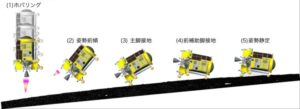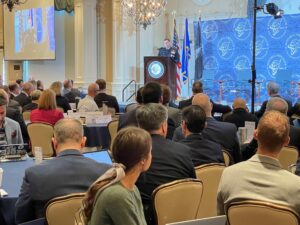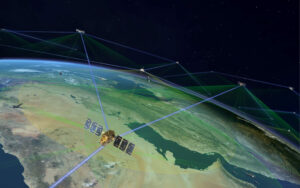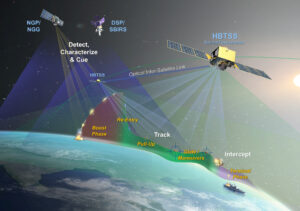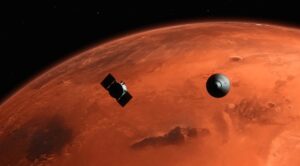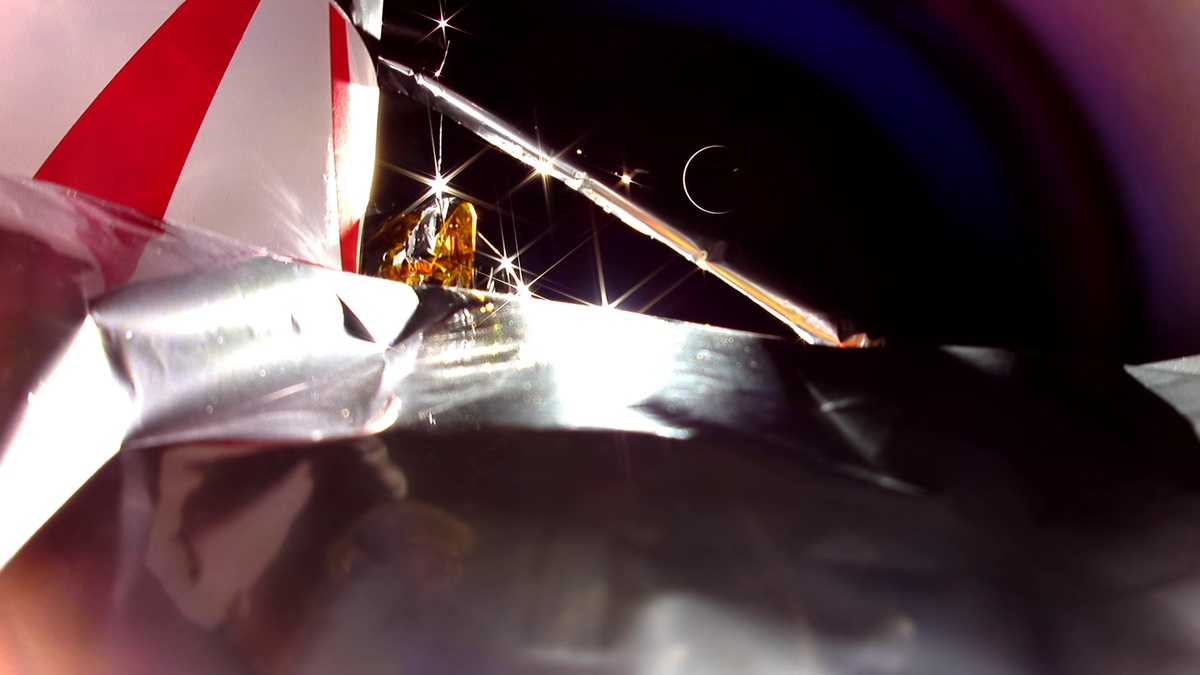
WASHINGTON — With the Peregrine lunar lander mission now complete, Astrobotic is turning its attention to understanding what went wrong with the spacecraft and incorporating any changes into a much larger lander for NASA.
U.S. Space Command confirmed Jan. 19 that Peregrine reentered the previous day, but did not provide a specific time or reentry location. Astrobotic had targeted a reentry in the South Pacific at around 4 p.m. Eastern Jan. 18.
In a call with reporters, John Thornton, chief executive of Astrobotic, said the company lost telemetry from the spacecraft at 3:50 p.m. Eastern and lost ranging with the spacecraft nine minutes later, “which aligns with our projected reentry at 4:04 p.m. Eastern.” At the time of the call, he said he was still waiting for confirmation of that reentry from U.S. government agencies, which came later in the call in the form of the Space Command statement.
The reentry ended Peregrine’s mission, which started more than 10 days earlier with a successful launch on a United Launch Alliance Vulcan Centaur. The spacecraft, though, suffered a propellant leak hours after liftoff that prevented the spacecraft from attempting a landing on the moon. The company elected to have the spacecraft reenter when it swung by Earth in its highly elliptical orbit rather than attempt a maneuver that could have sent it to the moon as originally planned.
Allowing Peregrine to reenter was a “difficult decision,” Thornton said. “The thing we were weighing was, should we send this back to Earth or should we take the risk to operate it in cislunar space?” Operating it longer could have involved having the spacecraft fly by or impact the moon, or possibly go into orbit around it, depending on the health of its propulsion system and remaining propellant.
Space safety led them to choose an Earth impact. “It’s important that we all act as responsible parties and make sure that we are keeping space available and accessible for all,” he said. Of particular concern, he later explained, was that continued use of the lander’s damaged propulsion system “could have possibly caused a catastrophic situation that would potentially create more debris.”
That decision was made in consultation with NASA, the largest customer of the mission through its Commercial Lunar Payload Services (CLPS) program. “Peregrine Mission One was Astrobotic’s mission and Astrobotic’s spacecraft, but as one of their big customers, we shared with them our view of the information,” said Joel Kearns, deputy associate administrator for exploration in NASA’s Science Mission Directorate. NASA provided recommendations to Astrobotic on how to proceed with the mission.
With the mission now complete, Astrobotic is focusing on investigating what went wrong. The leading hypothesis for the propellant leak remains a valve that failed to properly reseat in a helium pressurization system when it was initialized just after launch. “It sent a rush of helium down into the oxidizer side” of the propulsion system, Thornton said. In a little more than a minute, the pressure in the oxidizer tank exceeded the tank’s limits, causing a rupture.
The company plans to convene a review board to analyze the data to confirm what caused the propellant leak. That includes determining what corrective actions are needed for Griffin, the much larger lander Astrobotic is building to transport NASA’s Volatiles Investigating Polar Exploration Rover (VIPER) to the south polar region of the moon.
Griffin, for now, remains scheduled for launch in November, and Astrobotic continues to work on it as it investigates Peregrine. “The effect it would have on the Griffin mission depends on the findings,” Kearns said of the Peregrine investigation. “It’s a relatively short period of time from today in January until the end-of-year Griffin mission, so we will not want to rush the findings.”
He added that NASA will wait to see the results of the review before deciding to modify the CLPS award for transporting VIPER to the moon. “VIPER is a very visible, very sophisticated and costly payload,” he said. “We want to make sure we really understand the root cause and contributing factors of what happened on Peregrine.”
While Peregrine failed to land on the moon, Thornton played up what Peregrine was able to accomplish through the work of engineers and flight controllers. “Our mission control team in Pittsburgh kept their cool, they focused on the problem and they diagnosed what occurred,” he said of the company’s reaction to the propellant leak, reorienting the spacecraft so that its solar panels could generate power before its batteries ran out.
They were able to turn on payloads on board, including four NASA instruments, which returned data that scientists said is useful even though it was not collected from the surface of the moon as originally intended. “The data collected in flight sets the stage for understanding how some of our instruments may behave in the harsh environment of space when some of the duplicates fly on future CLPS flights,” Nicola Fox, NASA associate administrator for science, said in a statement.
Thornton said he was proud of the Astrobotic team for its work on the truncated mission. “We did not achieve the primary objective of landing on the surface of the moon,” he said, but after the initial anomaly “we just had victory after victory after victory, showing the spacecraft was working in space, showing that the payloads can operate and getting data back from those payloads.”
- SEO Powered Content & PR Distribution. Get Amplified Today.
- PlatoData.Network Vertical Generative Ai. Empower Yourself. Access Here.
- PlatoAiStream. Web3 Intelligence. Knowledge Amplified. Access Here.
- PlatoESG. Carbon, CleanTech, Energy, Environment, Solar, Waste Management. Access Here.
- PlatoHealth. Biotech and Clinical Trials Intelligence. Access Here.
- Source: https://spacenews.com/astrobotic-to-begin-formal-investigation-into-failed-peregrine-mission/
- :is
- :not
- ][p
- $UP
- 10
- 19
- 50
- a
- Able
- accessible
- accomplish
- Achieve
- Act
- actions
- added
- After
- agencies
- Aligns
- All
- Alliance
- an
- analyze
- and
- any
- ARE
- around
- AS
- Associate
- At
- attempt
- attempting
- attention
- available
- award
- back
- batteries
- before
- begin
- Big
- board
- Building
- but
- by
- call
- came
- CAN
- catastrophic
- Cause
- caused
- causing
- Changes
- chief
- Chief Executive
- Choose
- commercial
- company
- Company’s
- complete
- Concern
- Confirm
- confirmation
- CONFIRMED
- consultation
- continued
- continues
- contributing
- control
- Cool
- costly
- could
- create
- customer
- Customers
- data
- day
- Days
- Deciding
- decision
- Depending
- depends
- deputy
- determining
- DID
- down
- duplicates
- Earlier
- earth
- eastern
- effect
- elected
- ended
- Engineers
- Environment
- Even
- exceeded
- executive
- explained
- exploration
- factors
- Failed
- findings
- flight
- Flights
- focused
- focusing
- For
- form
- formal
- four
- fox
- from
- future
- generate
- getting
- Go
- Government
- government agencies
- Griffin
- had
- happened
- Have
- having
- he
- Health
- helium
- highly
- HOURS
- How
- How To
- HTTPS
- Impact
- important
- in
- includes
- Including
- incorporating
- information
- initial
- instruments
- intended
- into
- investigates
- investigation
- involved
- IT
- ITS
- Jan
- January
- joel
- John
- jpg
- just
- keeping
- kept
- Land
- landing
- larger
- largest
- later
- launch
- leading
- leak
- Led
- limits
- little
- location
- longer
- lost
- Lunar
- lunar lander
- made
- make
- May..
- minute
- minutes
- Mission
- Mission Control
- modify
- Moon
- more
- much
- Nasa
- needed
- nine
- November
- now
- objective
- occurred
- of
- on
- ONE
- operate
- operating
- or
- Orbit
- originally
- our
- out
- panels
- particular
- parties
- period
- pittsburgh
- planned
- plans
- plato
- Plato Data Intelligence
- PlatoData
- played
- polar
- possibly
- potentially
- power
- pressure
- prevented
- previous
- primary
- Problem
- proceed
- Program
- projected
- properly
- propulsion
- proud
- provide
- provided
- ranging
- rather
- reaction
- really
- recommendations
- Reenter
- region
- relatively
- remaining
- remains
- responsible
- Results
- review
- Risk
- root
- rover
- rush
- s
- Safety
- Said
- scheduled
- Science
- scientists
- see
- send
- sent
- Services
- Sets
- shared
- Short
- should
- showing
- situation
- So
- solar
- solar panels
- some
- sophisticated
- South
- Space
- spacecraft
- specific
- Stage
- started
- Statement
- Still
- successful
- sure
- Surface
- system
- Take
- tank
- targeted
- team
- than
- that
- The
- the information
- their
- Them
- they
- thing
- this
- those
- though?
- Through
- time
- to
- today
- transport
- transporting
- TURN
- Turning
- u.s.
- U.S. government
- understand
- understanding
- United
- until
- use
- useful
- valve
- very
- victory
- View
- visible
- vulcan
- wait
- Waiting
- want
- was
- we
- weighing
- went
- were
- What
- when
- which
- will
- with
- Work
- working
- would
- Wrong
- zephyrnet

